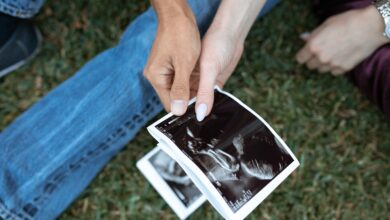childbirth

A presumed date of delivery is systematically scheduled nine months after the presumed date of the start of pregnancy, ie 41 WA (weeks of amenorrhea, that is to say weeks without periods) (1). For example, if the date of the last menstrual period is March 10, the start of pregnancy is estimated, in the case of regular ovulatory cycles, on March 24; the DPA is therefore set at December 24 (March 24 + 9 months). To make this calculation, the gynecologist or midwife uses a “pregnancy disc”.
However, this is only a theoretical date that different elements can influence:
- the duration of the cycle: this method of calculation is valid for regular cycles of 28 days
- the date of ovulation which can vary, even on a regular cycle, or even from one cycle to another
- the survival time of the egg and sperm, which can affect the date of fertilization
dating ultrasound
Another tool will make it possible to confirm or correct this first theoretical date: the first ultrasound of pregnancy carried out at 12 SA and moreover called “dating ultrasound”. During this ultrasound, the doctor will count the number of fetuses, check its vitality and carry out biometrics (taking measurements) which will make it possible to estimate the age of pregnancy and therefore the presumed date of delivery. Will be measured:
- the cranio-caudal length or LCC, which corresponds to the head-buttock length of the embryo
- the biparietal diameter or Bip, i.e. the diameter of the skull
These two values are compared with reference curves and allow dating of the pregnancy and an estimation of the age of the fetus to within 3 days. This ultrasound is considered the best method of dating pregnancy (2).
The duration of the pregnancy in question
Even if ultrasound can reliably date the age of pregnancy, there is still another piece of data that can affect the date of delivery: the duration of the pregnancy itself. However, this is also an estimate. Moreover, in many countries, the duration of pregnancy is not calculated at 9 months but a week earlier, i.e. 40 weeks (3). Depending on the calculation methods, genetic factors and certain maternal characteristics, the duration of pregnancy varies between 280 and 290 days from the first day of the last menstrual period (for a regular cycle of 28 days). The duration of pregnancy therefore varies between 40+0 and 41+3 weeks (4). A recent study (5) even showed that the average duration from ovulation to childbirth was 268 days (ie 38 weeks and 2 days) with strong disparities (up to 5 weeks) depending on the mothers.
- bridge
- Allergies (overview)
- Achluophobia : all about the fear of the dark
- At what age can you do bodybuilding?
- Fatigue in the morning: causes and remedies










